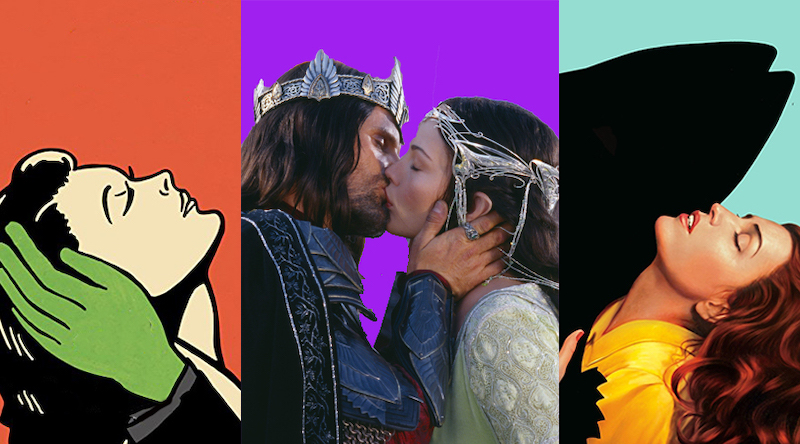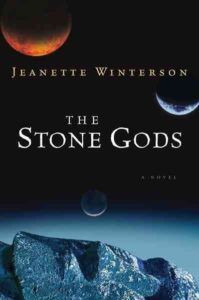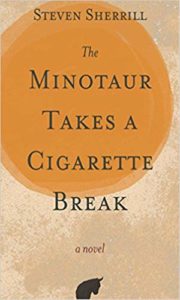
Valentine’s Day is upon us, folks. Yes, tomorrow, couples from sea to shining sea will be exchanging small tokens of affection, taking moonlit strolls by the river, and making love to the sounds of the ocean/subway train rattling past their apartment. Meanwhile, the country’s greeting card barons, bodega florists, and chalky chocolate hawkers will be sleeping soundly on mattresses stuffed with cash. As it was in the beginning, is now, and ever shall be.
As a tip of the cap to this annual day of ritualized l’amour, we thought we’d bring you a list of literature’s greatest love stories—tales of epic romances in far flung places, illicit trysts between star-crossed lovers, heaving bosoms and fiery loins. We considered Romeo and Juliet and Jane Eyre, Anna Karenina and Love in the Time of Cholera, A Sport and a Pastime and What Belongs to You, but none of them felt quite right. They were all so familiar, so…so…human.
What, we wondered, about the fictional characters whose taboo relationships are forever consigned to the shadows? The women whose passions are awakened by sea monsters, the men aroused by pieces of chopped liver, the bite-sized vampires looking for companionship? Will there ever be a day when they can take their rightful place alongside Anna and Vronsky, Florentino and Fermina, Anastasia and Christian, in the pantheon of great literary lovers?
Well, folks, today is that day. Here, in no particular order, are our ten favorite unconventional love stories.
Woman & Sea Monster
Mrs. Caliban by Rachel Ingalls (1982)
Revolutionary Road meets Swamp Thing. Ingalls novella is the story of a lonely, grieving American housewife in a dying marriage who finds both true love and sexual awakening in the form of an amphibious talking biped (recently escaped from a government lab) named Larry.
“Every one of its 128 pages is perfect, original, and arresting. Clear a Saturday, please, and read it in a single sitting … Ingalls’s narrative is a miracle of economy and grace. (Most of her books are novellas, which might explain her obscurity.) She writes straightforwardly, without winking, dropping only occasional hints that Dorothy’s tether on reality might be frayed … Larry’s connection to Caliban is clear enough—he is a frightening other to be feared, enslaved, and, when that fails, exterminated. As a romance, the book is tender; as a portrait of depression, exquisite and tragic. Dorothy can’t swim against the tides of grief and melancholia. Does Larry really exist? ‘This thing of darkness I acknowledge mine’ is not a statement that Mrs. Caliban ever utters.”
–Christine Smallwood (Harper’s)
*

Man & Elf
The Lord of the Rings by J.R.R. Tolkien (1968)
Tolkien’s urtext fantasy novel contains within its epic sweep one of the most iconic but-we’re-from-two-different-worlds love affairs in all of 20th century literature. I’m talking of course about the romance between mortal man Aragorn and the immortal elf-maiden Arwen.
“Mr. Tolkien is fortunate in possessing an amazing gift for naming and a wonderfully exact eye for description; by the time one has finished his book one knows the histories of Hobbits, Elves, Dwarves and the landscape they inhabit as well as one knows one’s own childhood … if one is to take a tale of this kind seriously, one must feel that, however superficially unlike the world we live in its characters and events may be, it nevertheless holds up the mirror to the only nature we know, our own; in this, too, Mr. Tolkien has succeeded superbly, and what happened in the year of the Shire 1418 in the Third Age of Middle Earth is not only fascinating in A. D. 1954 but also a warning and an inspiration. No fiction I have read in the last five years has given me more joy.”
–W. H. Auden (The New York Times)
*
Bounty Hunter & Shape-Shifting Man-Leopard
Black Leopard, Red Wolf by Marlon James (2019)
Tracker, the bounty hunter protagonist of the first volume in James’ “Dark Star” African fantasy trilogy, has a complicated relationship with his shapeshifter companion, who fills the role of ally, adversary, and lover over the course of their quest to find a missing child.
“The novel stands as an epic quest … With Black Leopard, Red Wolf, James reorients the reader using bygone Africa, its kingdoms and its conjuring, as his muse. And he’s a much better prose stylist than Tolkien, knowing when to let Tracker’s blustery voice take center stage and when it should become quieter, so the fantastic may dazzle us instead … James manages to write a fantasy novel that is both grounded and, simultaneously, playfully fantastic. This book might do his finest job yet of blending the horrific and the exquisite: There is love and lust and betrayal and faerie folk … Literature, no matter the genre, is meant to remind us that we might aspire to see and understand and embrace more than we’re naturally inclined to. The brilliant and bold Marlon James has already done this in one arena and now he’s poised to pull it off in another, tearing down some of the pillars of fantasy so the temple can be expanded and rebuilt.”
–Victor LaValle (Bookforum)
*

Woman & Robot
The Stone Gods by Jeanette Winterson (2007)
This self-referential, post-apocalyptic space love story from the author of Oranges Are Not the Only Fruit is chock-full of interesting and imaginative touches, one of which is the blossoming relationship between a sexy, soon-to-be-recycled-for-parts Robo Sapien named Spike, and the beautiful scientist/media expert/terrorism suspect, Billie Crusoe.
“Some of these significantly hidden connections are made with truly charming inventiveness. In the first section, the reduction of the robot Spike to a mere head is grotesquely sad; in the last section, Spike’s existence as a mere head that doesn’t have its body yet is grotesquely funny, particularly when Spike succeeds, as I think no other detached head has, in having sex … despite the gaspy bits, the purple bits, and the lectures, The Stone Gods is a vivid, cautionary tale—or, more precisely, a keen lament for our irremediably incautious species.”
–Ursula K Le Guin (The Guardian)
*

Minotaur & Woman
The Minotaur Takes a Cigarette Break by Steven Sherrill (2003)
Five thousand years on from the business with the labyrinth and the Minotaur, or M as he is known to his colleagues, is working as a line cook at a restaurant in Carolina, keeping to himself, trying in vain to put his past behind him. There, he falls for a sweet-natured, epileptic waitress named Kelly.
“…[a] wry, melancholy, beautiful first novel … The Minotaur Takes a Cigarette Break caused quite a stir when it was originally published by a local press in North Carolina three years ago, and only a year before American Gods, Neil Gaiman’s more epic rendition of the selfsame metaphor. However unusual its protagonist, the location is familiar enough in American fiction. It’s that marginal territory mapped out by Ray mond Carver, Louise Erdrich and Carolyn Chute: the realm of the dispossessed, casual workers inhabiting peeling clapboard duplexes in the shadow and stink of the Purina Dog Chow factory. Here, life is all provisional arrangements and substitutes … Maybe Kelly will make a difference. It is Sherrill’s genius, as we last see the Minotaur standing baffled in the darkened trailer park at three o’clock in the morning, to make us hope so too.”
–Colin Greenland (The Guardian)
*
Woman & Merman
The Pisces by Melissa Broder (2017)
This love story between a human and the ocean’s second sexiest inhabitant (bioluminescent jellyfish, don’t @ me) makes Splash look positively chaste by comparison. Lucy is a frustrated academic who, while dog-sitting for her sister in Los Angeles and trying to get over a bad break-up, begins a torrid sexual affair with a ripped Venice Beach merman.
“Broder has a way of writing about shame that recalls a Zamboni, methodically circling and recircling a surface until it looks clean. But So Sad Today was also, as Broder put it, ‘pickled by the Internet,’ steeped in the ethos of relatability, of broad-denominator personal identification. In The Pisces, Broder takes her obsessions and gives them a perverted mythological structure, and corrals them within the arbitrary limits of fiction. ‘Who was I if I wasn’t trying to make someone love me?’ Lucy asks. The question is more interesting—funnier, sadder—when asked in a novel by a person who’s about to put on a skirt so that a merman can perform oral sex on her than it is when asked on Twitter, a platform which takes that question as its fundamental premise … With [Theo], Broder makes the abject itself into a love interest. Lucy is drawn, in Kristeva’s terms, ‘toward the place where meaning collapses.’ The Pisces convincingly romances the void.”
–Jia Tolentino (The New Yorker)
*

Boy & Vampire
Let Me In by John Ajvide Lindqvist 2007)
Part horror novel, part revenge tale, part love story between two lonely souls: this bestselling, pitch black Swedish novel concerns Oskar—a bullied 12-year-old-boy living a working-class Swedish suburb in the early 1980s—and his relationship with a centuries-old vampire child named Eli who moves in next door.
“Although it does have its grotesque, over-the-top moments, the book is wonderfully bleak and spare. Unlike Anne Rice’s hedonistic bloodsuckers, Lundqvist’s vampires are sad, lonely creatures who simply want to survive, taking little pleasure in what is required to do so. If there is one complaint, it is that the author sets the book entirely in the fall, and so cannot exploit the obvious advantages and disadvantages of being a Swedish vampire—24-hour darkness during winter, but midnight sun in summer.”
*
Woman & Ghost/Hallucination/???
The Third Hotel by Laura van den Berg (2018)
A dreamlike, noir-ish novel about widowed elevator sales rep who travels to Havana for a film festival after her horror-film scholar husband, Richard, is killed in a hit-and-run near their home in Upstate New York. When she arrives in the city, she spots a man who looks exactly like Richard, becomes convinced her husband has somehow been resurrected, and begins obsessively searching for him.
“Strange, unsettling, and profound from start to finish, The Third Hotel is a book teeming with the kind of chaos that can only emanate from the mind. It could be fairly described as a meditation on grief, or marriage, or travel; fresh insights on each materialize regularly, at enviable levels of nuance … Laura van den Berg channels genre masters like Hitchcock and such evocative literary works as, particularly, Juan Rulfo’s Pedro Páramo. She gets under your skin and hits bone. Hers is a terror tale as mercurial as life, veering between the grisly and the gentle … An award-winning writer of short fiction, van den Berg is a storyteller of astonishing detail. Her descriptions—whether concise or elongated—simply demand attention … Van den Berg can be heavy-handed with the parallels she draws, the big ideas she’s confronting, but it’s all in service of this masterpiece of life and afterlife.”
–David Canfield (Entertainment Weekly)
*
Man & Liver
Portnoy’s Complaint by Philip Roth (1969)
Roth followed up his first (and only) novel with a female protagonist (1967’s When She Was Good) with this comic tale of “a lust-ridden, mother addicted young Jewish bachelor” confessing his sexual desires and frustrations, as well as his elaborate masturbation habits, in a continuous monologue to his therapist. You’ll never look at liver the same way again.
“Now, with Portnoy’s Complaint, Philip Roth has finally come up with the existentially quintessential form for any American-Jewish tale bearing—or baring—guilt. He has done so by simply but brilliantly casting his American Jewish hero—so obviously long in need of therapy—upon a psychoanalysts’s couch (the current American-Jewish equivalent of the confessional box) and allowed him to rant and rave and rend himself there. The result is not only one of those bullseye hits in the ever-darkening field of humor, a novel that is playfully and painfully moving, but also a work that is certainly catholic in appeal, potentially monumental in effect—and, perhaps more important, a deliciously funny book, absurd and exuberant, wild and uproarious.”
–Josh Greenfield (The New York Times)
*
Man & Sex Doll
Made for Love by Alissa Nutting (2017)
Tampa-author Nutting’s latest is a comic novel set in the near future about a woman who, after running out on her marriage to a megalomaniacal tech company CEO, moves into a trailer park for senior citizens where her aging father lives with his beloved sex doll, Diane.
“…[a] smart, riveting novel … The book begins, and races along, as an antic thriller, through a circus’s worth of set pieces (sex dolls, lawn flamingoes, motorized wheelchairs, bestiality with dolphins), but throughout and underneath this supersaturated masquerade Hazel tells the darkest, baldest, saddest truths. Her aphoristic, hyperanalytical, deftly extemporaneous takes on love, intention, sex, childhood and gadgets are a pleasure to read and always hit their mark; they are also the interesting and entirely believable productions of a character whose self-awareness far outstrips her self-determination … Like the best episodes of Black Mirror, Made for Love provokes the disturbing realization that we are, more or less, already living in the time portrayed as a couple of steps beyond too much … Made for Love crackles and satisfies by all its own weird rules, subversively inventing delight where none should exist. How can a book be so bright, and so dark?”
–Merritt Tierce (The New York Times Book Review)

